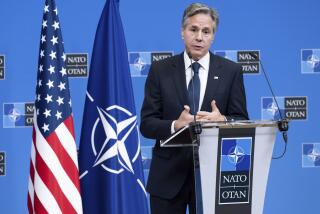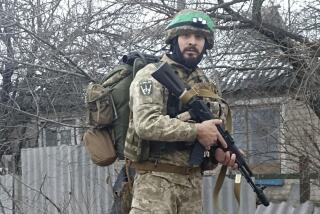Unheralded military successes
- Share via
When I visited Arauca province in northeastern Colombia in February 2003, it was considered the most dangerous part of the country. Attacks by narco-terrorists using improvised explosive devices, or IEDs, and cylinder and car bombs occurred every few hours. U.S. Army Special Forces members, who were in the province to train Colombian army troops, left their base only in full battle-rattle -- that is, in body armor with guns at the ready -- just like in Iraq. The town of Arauca was a ratty sprawl of tacky storefronts with awnings made of black plastic, the kind used for garbage bags. Attacks on the pipeline carrying Colombian oil to the Caribbean coast were unrelenting.
By last year, though, there had been dramatic change: Proper cafes were open, storefronts were painted, crowds flooded the streets -- at night too.
Four years ago, I had journeyed through Arauca’s streets inside a convoy of Humvees armed with light-medium machine guns. In the middle of town, I’d stayed put in my Humvee. More recently, I rode in the open back of a pickup with a handful of U.S. and Colombian soldiers armed with nothing more substantial than Beretta pistols, and motorcycle escorts with a few assault rifles. In town, I walked the streets with Army Capt. Troy Terrebonne of Houston, who told me, “Wherever you want to go, we can go, on foot. It’s safe here.” The last IED attack in the town had been 18 months earlier.
Arauca is still troubled, with reports of the occasional extra-judicial killing. But it is broadly moving in the right direction.
There has been no magic-bullet solution in Colombia, no newsworthy technique that you could write about. It was just bread-and-butter, never-give-up, attrition-of-the-same. The Green Berets provided small-unit training that raised the combat ability of the Colombian military, making it more aggressive in hunting down the drug armies as well as more aware of human rights as a pivotal tool in counterinsurgency. Meanwhile, State Department aid came with an implicit proviso: The Colombian army should put more emphasis on medical, education and social programs to secure the goodwill of the inhabitants.
As Colombia has gone, so has the Philippines. Before 9/11, the southern island of Basilan was a Muslim terrorist hide-out. In 2002, with the help of Green Berets, Filipino army forces cleared it. By last year, Manila-based businesses felt safe enough to invest there. When I visited last year, Basilan had cellphone towers, more roads and bridges paved with asphalt, more schools and increased agricultural production. Power outages were common because of surges in demand, a sign of uneven development but of development nevertheless.
Between risk-prone invasions like Iraq, on the one hand, and isolationism, on the other, the missions in Colombia and the Philippines showcase low-cost, low-risk and tediously unspectacular counterinsurgency options. And these places are not alone. Other U.S. military deployments I have observed recently -- in Algeria, Mali, Niger, Kenya, Georgia and Nepal -- are variations in a minor key. What stands out about all of these missions is their small scale and implicit modesty. We are not in combat in any of these countries -- but, rather, training local militaries that are or might be.
In all these countries, our military aid is combined with civilian development assistance. This is the global war on terrorism as preventive rather than as proscriptive. It doesn’t cost much. You could spread Green Beret teams across Africa for the price of one F-22 jet. If there is another model out there that will keep the U.S. military engaged without overextending it, and will help move along inter-agency cooperation, I have not seen it.
I mention these deployments because there is an attitude gaining currency in media and policy circles that lumps everything our military is doing abroad with Iraq. It says that our armed forces are overextended, that we are using them to force our democratic ideals down people’s throats and that we need to be more humble and less militaristic. But on a deployment-by-deployment basis, the truth couldn’t be more different.
The overwhelming majority of our deployments abroad are neither bellicose nor utopian. To the contrary, they are the epitome of half-measures -- using a few hundred troops at the most, usually just a few dozen. These missions are full of compromises with the host nation and recognize on a daily basis our military limitations. The host nations have been overwhelmingly democratic and have evolved as such during the years of our deployments. In most cases, they specifically requested our military assistance. Not to assist these fledgling democracies would be irresponsible, given our resources and historic role as a great power.
The same largely hidden, responsible hand that we see in places such as Colombia and the Philippines was much in evidence in Eastern Europe in the 1990s in the form of military training missions, conducted primarily by the United States. Those missions helped ease the transition of former Warsaw Pact satellites to democracy. The Westernization of the militaries of Poland, Romania and other East European countries was crucial to these countries’ political reformation.
The threat of anarchy exists in many parts of the world. But nation building is vastly expensive and the outcome uncertain. Is there thus anything more morally prudent and cost-effective than crisis prevention? Crisis prevention has many facets, and the small-scale U.S. deployments the world over represent a military aspect of it.
The near-absence of news coverage about these missions testifies to their subtlety, even as none of them have been secret. As for some of the costlier deployments we conduct -- such as sailing carrier strike groups through choke points such as the Strait of Malacca -- where would international trade and globalization be if the U.S. Navy suddenly ceased protecting the sea lanes? To define all these missions by their imperfections, or to lump everything together with Iraq, is to tempt isolationism.
I understand and respect the impulse of those who want to reassess our commitments because of our troubles in Iraq and the strain that conflict places on our armed services. But there is a danger in taking that idea too far. After all, Iraq, though lately improving, still represents a quagmire. Places such as Colombia and the Philippines represent what works. Just look at Arauca.
More to Read
Sign up for Essential California
The most important California stories and recommendations in your inbox every morning.
You may occasionally receive promotional content from the Los Angeles Times.










